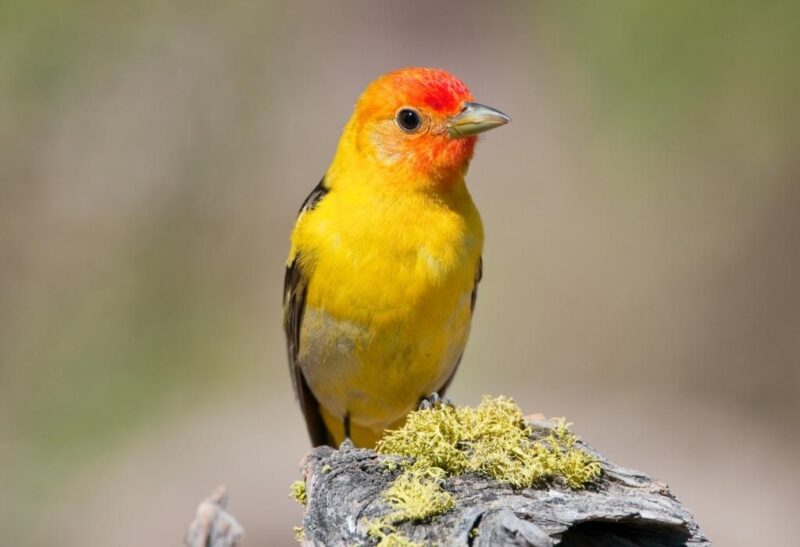When discussing birds with brightly colored plumages, the first thought would most likely be peacocks who are known for their multi-colored tail feathers or flamingos that have distinctive pink plumage. There are also a considerable number of other birds that have bright yellow-colored bellies.
Birds with yellow bellies are the Tropical Kingbird, Couch’s Kingbird, Brown-chested Flycatcher, Lesser Goldfinch, Western Tanager, Yellow-bellied Flycatcher, Evening Grosbeak, American Goldfinch, Golden-crowned Warbler, Yellow-bellied Siskin, and more for a total of 22 bird species with yellow bellies.
This article will serve as a guide to everything you need to know about birds with yellow bellies, their physical attributes, food preferences, distinctive characteristics, and more interesting information!
Table of Contents
22 Birds With Yellow Bellies
Tropical Kingbird

Tropical Kingbirds are distinguished from other kingbird species by their large beaks, slightly notched tails, and high-pitched twittering calls. They’re mostly found in open woodland areas with temperate and tropical climates, usually near streams, ponds, and river edges.
- Scientific Name: Tyrannus melancholicus
- Appearance: Large flycatcher with a large head, long and heavy bill, long and forked tail with a shallow notch found on the center, and broad, pointed wings.
- Color: Gray head with darker-colored cheeks, whitish neck area, olive green chest area, yellow underparts, black beaks and feet, dark gray-brown wings, and whitish gray covert wings and tail.
- Lifespan: Unknown
- Body Length: 18 to 23 centimeters
- Weight: 32 to 43 grams
- Wingspan: 12 centimeters
- Diet: Primarily insects such as beetles, termites, bees, wasps, butterflies, moths, grasshoppers, and dragonflies but they also feed on seeded fruits and berries.
- Place of Origin: America
- Characteristics: Diurnal and territorial. Some populations migrate in flocks consisting of 20 to 30 individuals, while others are sedentary and are usually found in pairs all year round or in groups of 2 to 5 after the breeding season.
Couch’s Kingbird
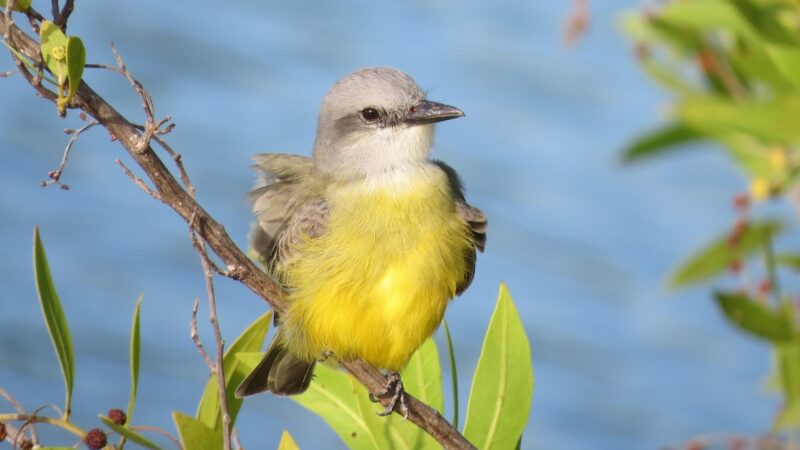
Nearly indistinguishable from tropical kingbirds in terms of appearance. In fact, they were considered a subspecies of the latter until 1980, when they were restored as a separate species. Couch’s Kingbirds inhabit lightly wooded areas, forests, stream edges, and plantations.
- Scientific Name: Tyrannus couchii
- Appearance: Large flycatcher with a bulky body, straight and flattened beak, long and slightly notched tail, and long wings
- Color: Pale gray head with a lemon yellow breast, dull yellow breast, whitish chin and throat, a red-orange patch on the top portion of the head that is usually hidden unless raised, olive-brown back, brown wings, dark brown tail, and black beaks, legs, and feet.
- Lifespan: Unknown
- Body Length: 18 to 23.5 centimeters
- Weight: 43 grams
- Wingspan: 38 to 41 centimeters
- Diet: Mostly flying insects and fruits of plants such as magnolia, strangler fig, chinaberry, and black poisonwood. They occasionally feed on other non-insect arthropods.
- Place of Origin: Eastern Mexico, Northeastern Guatemala, Belize, and South Texas
- Characteristics: Diurnal, highly territorial, and migrates in small flocks made of up to 50 birds. They’re relatively social as they also join groups of other bird species during winter, such as green jays and golden-fronted woodpeckers.
Brown-Crested Flycatcher
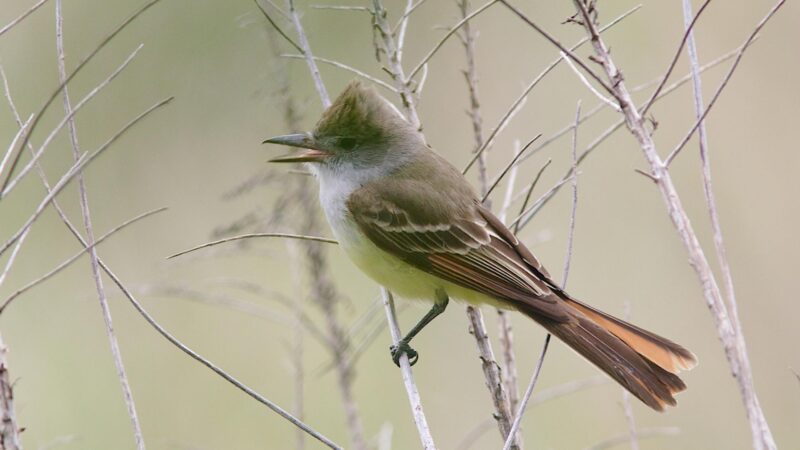
Extremely noisy and aggressive flycatchers that are known to live in the canopies of riparian forests. Brown-crested Flycatchers have a distinctive trilled song and sharp calls that sets them apart from other similar flycatcher species.
- Scientific Name: Myiarchus tyrannulus
- Appearance: Relatively large flycatcher with a peaked head, heavy and straight beak, and long tail
- Color: Brown-peaked head, gray upper breast and throat, bright or light lemon yellow belly and under tail feathers, reddish or rufous-highlighted tails and primary feathers, and pale wing bars
- Lifespan: Up to 11 years
- Body Length: 18.4 to 22.2 centimeters
- Weight: 21 to 40 grams
- Wingspan: 33 centimeters
- Diet: Insects such as beetles, true bugs, weevils, moths and their larvae, and grasshoppers. They also feed on the fruits of cardon cactus, giant saguaro, and guamuchil.
- Place of Origin: Southwestern US, Arizona, Brazil
- Characteristics: Highly territorial, medium or short-distance migrants, and diurnal
Lesser Goldfinch
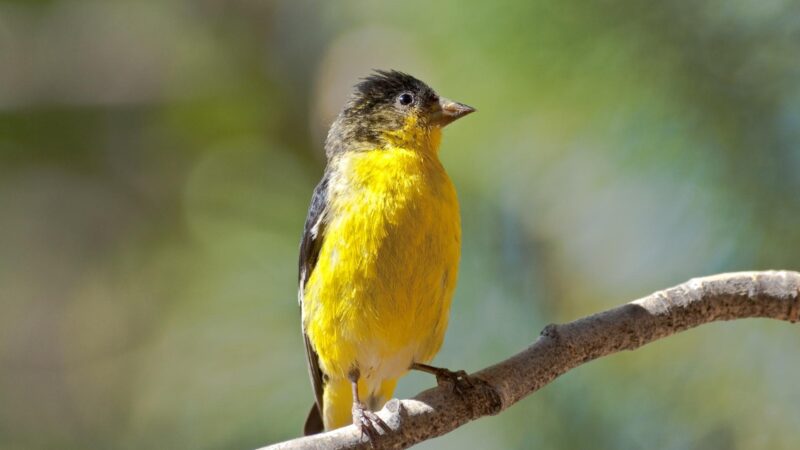
Lesser Goldfinches can be spotted feeding on grains and seeds among other seed-eating songbirds at feeder stations and at the tops of tall trees in cottonwood, scrubby oak, and willow habitats. They’re tiny but quick birds that hover and jerk their tails while eating.
- Scientific Name: Spinus psaltria
- Appearance: Tiny songbirds that have stocky bodies, long and pointed wings, stubby bills, and short, pointed tails
- Color: Males have black wings and white witch patches. Those located in the Eastern and Southern parts of their geographic range have glossy black backs, while those found in the Western parts have green backs. On the other hand, females have olive backs and black wings with 2 white wing bars. Both sexes have bright yellow underparts from their throat to their undertail coverts.
- Lifespan: 1 to 7 years (wild)
- Body Length: 9 to 11 centimeters
- Weight: 6 to 11.5 grams
- Wingspan: 61.2 to 65.1 millimeters
- Diet: Mainly seeds of species from the sunflower family, but they also feed on elderberries, coffeeberries, and madrone fruits, as well as the buds of oaks, cottonwoods, willows, and sycamores.
- Place of Origin: Southwestern United States, Peru, Venezuela
- Characteristics: Highly social and mostly seen in flocks consisting of 4 to 6 individuals. During migration, they form flocks made up of 20 to 30 members that may contain other species of goldfinches. They’re highly territorial and diurnal.
Western Tanager
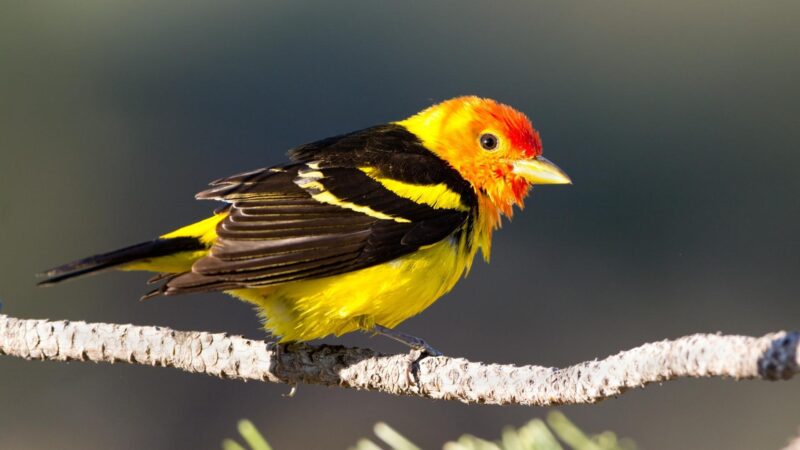
Typical woodland summertime residents, Western Tanagers often fill the woods with their loud, hoarse songs and distinctive chuckling calls. Their redness is due to rhodoxanthin, a rare pigment that’s obtained from the insects found in their diets.
- Scientific Name: Piranga ludoviciana
- Appearance: Small, heavy, and stocky-bodied songbirds with short but thick beaks, rounded wings, and medium-length, fan-like tails
- Color: Males have bright yellow plumage, red-orange heads, black backs and tails, and black wings with 2 wing bars that are yellow and white in color. Females have pale yellow plumage, with reddish front faces, grayish backs and tails, and black wings with 2 white wing bars.
- Lifespan: Up to 15 years
- Body Length: 16 to 19 centimeters
- Weight: 24 to 36 grams
- Wingspan: 28 to 30 centimeters
- Diet: Primarily insects such as wasps, dragonflies, ants, stink bugs, termites, grasshoppers, and cicadas. They also feed on fruit, particularly during the fall and winter seasons, such as wild cherries, hawthorns, elderberries, and mulberries, as well as feed occasionally on the buds of greasewood bushes
- Place of Origin: Western North America
- Characteristics: Diurnal, territorial, and often found in large but loose flocks during migration. However, they can also migrate alone or in pairs.
Yellow-Bellied Flycatcher
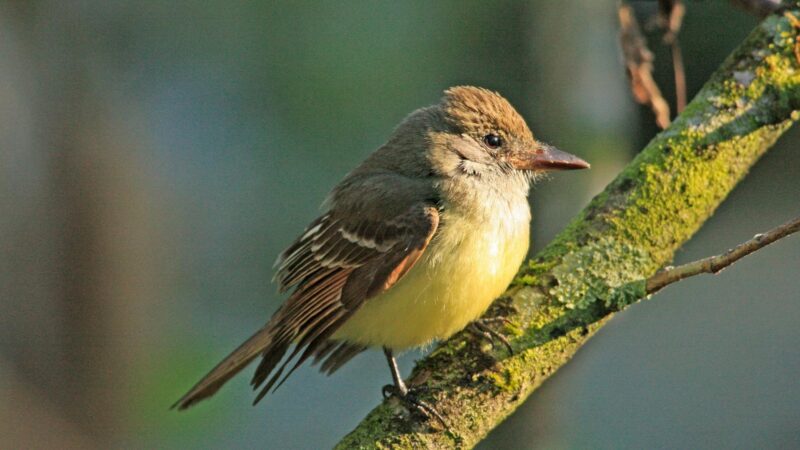
Belonging to an infamously elusive genus, the Yellow-bellied Flycatchers can be identified by their harsh, abrupt, and high-pitched rising songs and calls. They inhabit forested areas with moist environments and preferably near bodies of water.
- Scientific Name: Empidonax flaviventris
- Appearance: Small flycatchers that have compact bodies, big eyes with bold eye rings, large heads that may peak at the rear portion, short tails, and small but wide beaks
- Color: Yellowish olive plumage, bright green backs, light-colored eye rings, and 2 whitish wing bars
- Lifespan: Up to 5 years
- Body Length: 13 to 15 centimeters
- Weight: 9 to 16 grams
- Wingspan: 18 to 20 centimeters
- Diet: Insects such as beetles, crane flies, flying ants, stoneflies, mosquitos, and caterpillars. They occasionally feed on fruits such as poison ivy.
- Place of Origin: Canada, Northeastern United States
- Characteristics: Diurnal, migratory, and territorial. They are often quiet during the breeding season, which makes them more difficult to spot.
Evening Grosbeak

Despite being classified as songbirds, Evening Grosbeaks don’t use any “songs” or complex sounds that are used to either defend their territories or attract potential mates. They do, however, perform simple calls.
- Scientific Name: Hesperiphona vespertina
- Appearance: Large finches that have stock bodies, large and thick cone-shaped bills, thick necks, relatively short tails, and a full chest
- Color: Males are dominantly black and yellow with dark heads, a bright yellow stripe above their eyes, and pale ivory beaks, while females have a mostly gray plumage with black and white wings, a greenish-yellow hue in their neck and flank areas, and greenish-yellow beaks.
- Lifespan: Up to 16 years (wild)
- Body Length: 16 to 18 centimeters
- Weight: 53 to 74 grams
- Wingspan: 30 to 36 centimeters
- Diet: During the summer season, they primarily eat invertebrates such as aphids, caterpillars, and spruce budworm larvae. In breeding seasons, they feed on seeds such as those of apples, cherries, maples, elms, and pines, as well as small fruits such as juniper berries and snowberries.
- Place of Origin: North America
- Characteristics: They’re social and are usually seen traveling in noisy flocks during winter around suburban communities. However, they become elusive during the breeding season and territorial during the winter season. They’re nomadic as they will leave their current territories and find new ones when food is scarce.
American Goldfinch
Tiny finches that are regular visitors of bird feeders, American Goldfinches are easy to spot throughout their geographic range. Locals can easily attract them by planting native thistles and other species of composite plants.
- Scientific Name: Carduelis tristis
- Appearance: Small-sized finch that has a small head, short but sharp conical beak, short and notched bill, and long wings
- Color: In the spring and early summer seasons, males have bright yellow plumage with black foreheads, black wings with white-colored markings, and white patches on the tail, while females are a duller yellow color on their underparts and an olive plumage on their upper parts. During winter, both sexes become drab and have dull, brownish-black wings.
- Lifespan: 3 to 10 years (wild)
- Body Length: 11 to 13 centimeters
- Weight: 11 to 20 grams
- Wingspan: 19 to 22 centimeters
- Diet: Almost exclusively feeds on seeds, including those of sunflowers, asters, thistles, grasses, and trees such as elms, alders, and birches
- Place of Origin: North America
- Characteristics: Diurnal, non-territorial, and social birds that are usually found in small groups while foraging for food. They’re both nomadic and migratory as they settle in territories only for short periods of time and then move to a new one.
Golden-Crowned Warbler
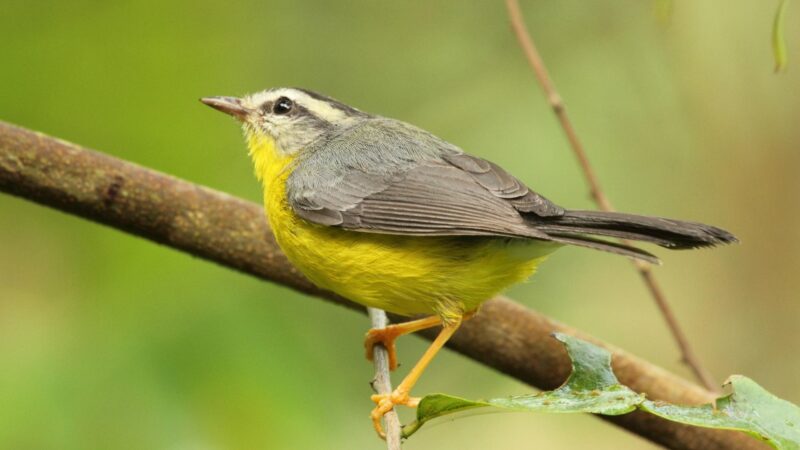
Golden-crowned Warblers commonly occur in montane and premontane forests and deciduous or evergreen woodlands. Their golden coloration is mostly inconspicuous. In fact, birdwatchers will more likely hear and recognize them through their distinctive insect-like calls.
- Scientific Name: Basileuterus culicivorus
- Appearance: Small birds with pointy beaks and shorter wings, compared to other warbler species
- Color: Their backs range from deep mouse gray, dark gray-olive, olive, to dark citrine, while their underparts (including the undertail-coverts) vary from white to bright yellow, depending on their location in their geographic range.
- Lifespan: Unknown
- Body Length: 12.7 centimeters
- Weight: 10 grams
- Wingspan: 17.78 centimeters
- Diet: Mainly insects and spiders, but they also occasionally feed on fruits, berries, and seeds.
- Place of Origin: Latin America
- Characteristics: Diurnal, migratory, and relatively social birds compared to other species of warblers, as they’re often found in pairs or in flocks.
Yellow-Bellied Siskin
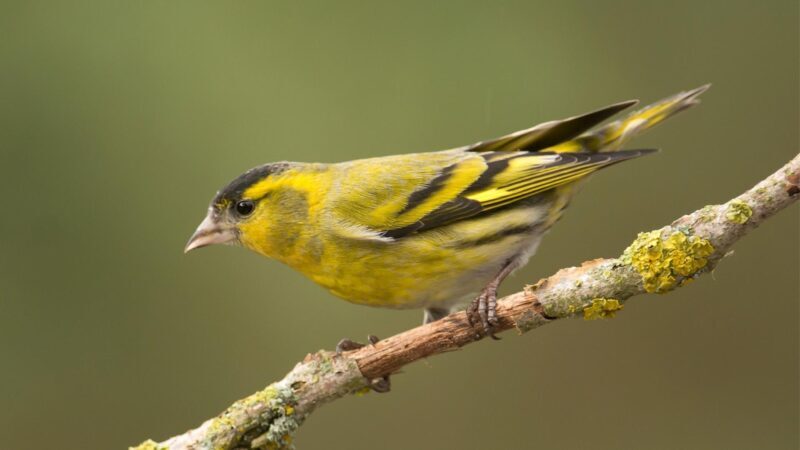
Yellow-bellied Siskins are residents of the edges and canopies of humid broadleaf and mountain oak forests. They belt out a series of twittering notes that can be high-pitched or harsh and scratchy, but usually, it is the males who sing for social purposes.
- Scientific Name: Spinus xanthogastrus
- Appearance: Small passerine bird with a short, conical beak and short legs
- Color: Males have blackheads (including their hoods) and upperparts with yellow underparts and a yellow patch on their wings. Females are a drabber yellowish-green color (including their heads and hoods), but they also have the same yellow wing patch.
- Lifespan: Up to 5 years
- Body Length: 10 to 11.5 centimeters
- Weight: 12 grams
- Wingspan: Unknown
- Diet: Mainly plant material such as leaves and seeds, but they also feed on insects and berries.
- Place of Origin: North and South America
- Characteristics: Diurnal, migratory, and are usually seen in pairs or small groups.
Blue-Winged Warbler
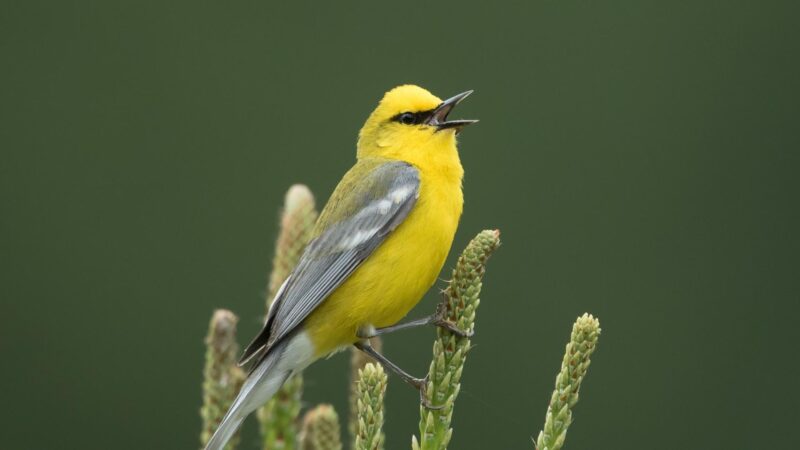
Blue-winged Warblers can easily be found during their breeding season when they sing a distinguishable bee-buzz sound coming from brushy fields. They bore a genetic similarity with Golden-winged Warblers and are even known to hybridize with them.
- Scientific Name: Vermivora pinus
- Appearance: Small birds that have ideal proportions and thin but sharp, pointed bills
- Color: Males have a bright yellow coloration below and yellowish-green above, blue-gray wings with 2 wing bars, and a distinctive black eyeline. Females are paler in plumage with a less bold eyeline. Both have undertail coverts that are white.
- Lifespan: Up to 9 years (wild)
- Body Length: 11 to 12.7 centimeters
- Weight: 7.9 to 10.5 grams
- Wingspan: 12 to 17.15 centimeters
- Diet: Mostly insects such as grasshoppers, caterpillars, flies, crickets, ants, and beetles
- Place of Origin: North America
- Characteristics: Solitary unless during the breeding season and taking care of offspring. They’re known to be territorial and aggressive during the breeding season. They’re also diurnal and migratory.
Kirtland Warbler
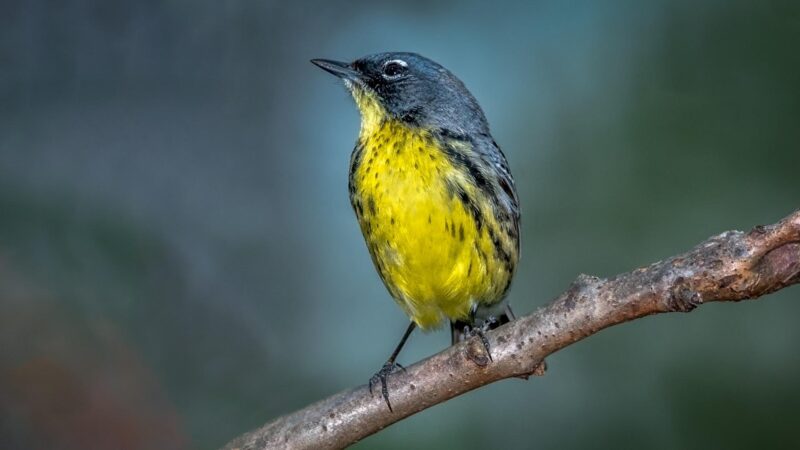
Kirtland Warblers were once considered an endangered species, with only 167 pairs existing in 1986 but have seen a significant increase estimated at 2,245 pairs as of 2021. They’re habitat specialists, only breeding in young and dense jack pine forests in Michigan, Ontario, and Wisconsin.
- Scientific Name: Setophaga kirtlandii
- Appearance: Large and plump-bodied warbler with a relatively short, bobbing tail
- Color: Males are bluish-gray above, lemon yellow below, and black-streaked on their sides. Their gray heads have a black mask and a broken eye-ring outlining the top and bottom of the eye. Females are also patterned similarly, but they’re not as stark in color and are more brownish on their upperparts. They also lack face masks.
- Lifespan: Up to 9 years
- Body Length: 14.6 to 15.24 centimeters
- Weight: 14 to 16 grams
- Wingspan: 22.2 centimeters
- Diet: Mostly insects such as beetles, spittlebugs, ants, wasps, and beetles and fruit. They also feed on nectar during the winter season.
- Place of Origin: North America
- Characteristics: Extremely territorial
MacGillivray’s Warbler
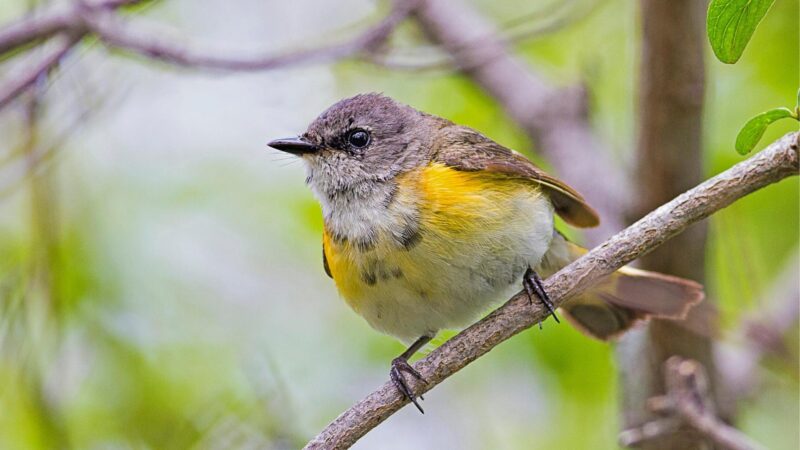
Deemed as heavy, slow-moving birds, MacGillivray’s Warblers occur in coniferous forests, dense shrubs found in mountain regions, and riparian corridors. They’re shy and elusive warblers, especially during the winter season.
- Scientific Name: Geothlypis tolmiei
- Appearance: Small, chunky-bodied warblers with long legs and sharp beaks
- Color: Olive green upperparts, yellow underparts, gray hood (including head and neck). They have white eye crescents located on the upper and lower eye. Females have paler hoods compared to males.
- Lifespan: Up to 4 years
- Body Length: 10 to 15 centimeters
- Weight: 8.6 to 12.6 grams
- Wingspan: 7.5 centimeters
- Diet: Insects such as true bugs, beetles, weevils, bees, wasps, caterpillars, and ants
- Place of Origin: Central America, Western United States, Western Canada
- Characteristics: Diurnal, migratory, territorial, and solitary except when forming seasonal monogamous pairs
Canada Warbler
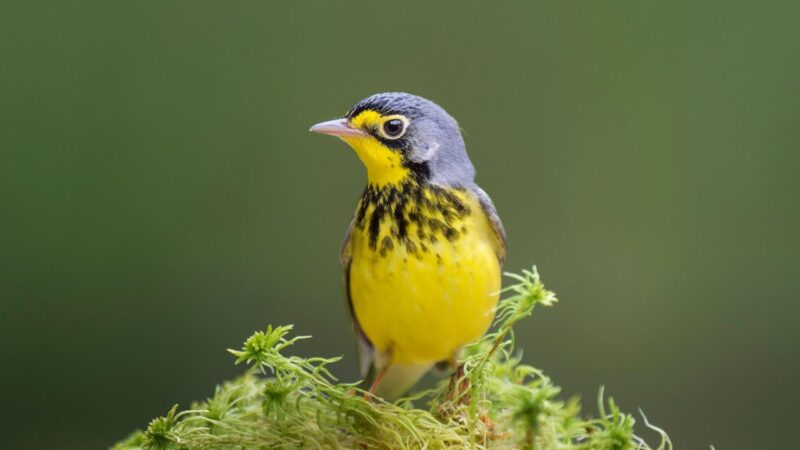
Often referred to as the Necklaced Warbler due to their identifiable bold markings across their chests, Canada Warblers can be spotted in their wintering grounds found in understory shrubs or in their breeding grounds located in boreal forests.
- Scientific Name: Cardellina canadensis
- Appearance: Small to medium-sized birds with well-proportioned bodies, full chests, straight and sharp bills, and a relatively long tail compared to other species of warblers
- Color: Steel blue-gray upperparts and bright yellow underparts with a white ring around the eye. They have distinctive black or bluish-black necklace-like markings across the chest. They also have white coloration on their undertail coverts and lack wing bars.
- Body Length: 12 to 15 centimeters
- Weight: 9.5 to 12.5 grams
- Wingspan: 20 to 22 centimeters
- Diet: Mostly flying insects such as beetles, mosquitoes, moths, and flies. They also feed on caterpillars, insect larvae, and spiders.
- Place of Origin: North and South America, Canada
- Characteristics: Diurnal and migratory birds that are often seen alone or in pairs. They’re extremely territorial, especially during the breeding season.
Wilson’s Warbler
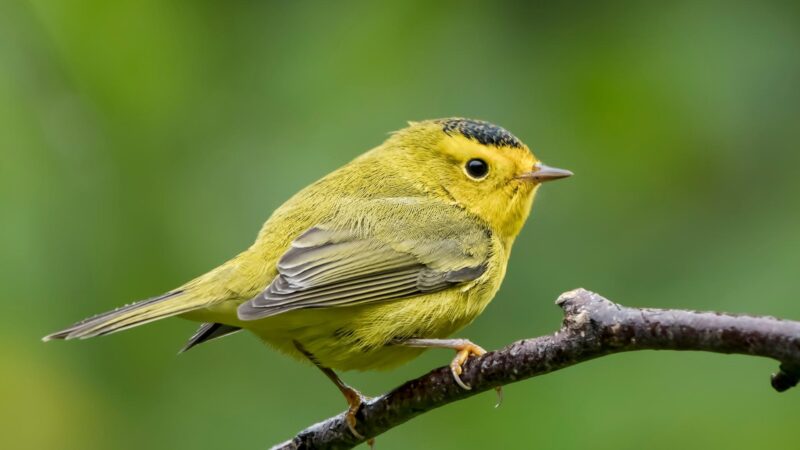
Wilson’s Warblers are found in forest edges and shrubby thickets in wooded areas and are relatively easier to spot compared to other species of warblers. They have little to no fear of humans and are usually foraging on visible leafy branches.
- Scientific Name: Cardellina pusilla
- Appearance: Small songbirds with short, thin beaks, thin legs, and long tails
- Color: Males have yellowish to olive-green upperparts with a bold, black head cap and lemon yellow underparts. Females have a similar appearance, but the cap may be olive, black with olive patterns, black but olive-tipped, or entirely black.
- Lifespan: Up to 6 years (wild)
- Body Length: 10 to 12 centimeters
- Weight: 5.4 to 10.5 grams
- Wingspan: 17.78 centimeters
- Diet: Insects such as stoneflies, mayflies, beetles, aphids, and bees. They also feed on spiders and caterpillars. Occasionally, they will consume non-aquatic larvae if they’re available, as well as berries during the fall season.
- Place of Origin: Northern Canada and Western United States
- Characteristics: Diurnal, migratory, territorial, and generally solitary except during the mating season
Yellow Warbler
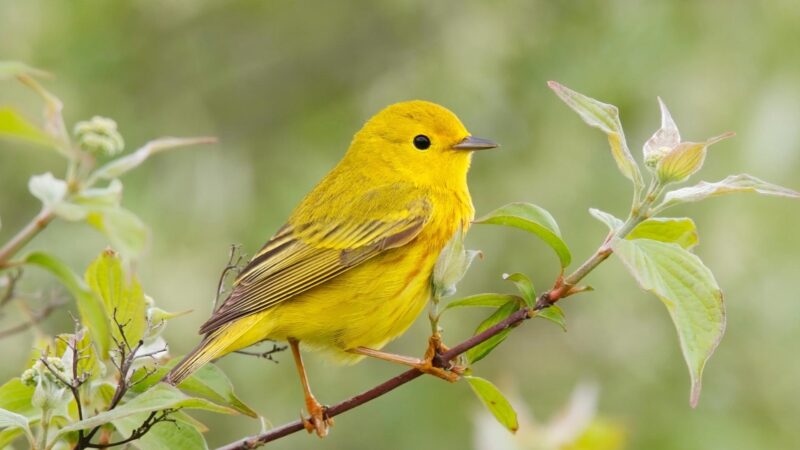
Distinguishable warblers due to their extensive yellow plumage compared to other warblers, Yellow Warblers are usually found near bodies of water or in shrubs located in wetlands. Latin American populations nest in mangroves, hence, their nickname: Mangrove Warblers.
- Scientific Name: Setophaga petechia
- Appearance: Small warblers with even proportions, rounded heads, medium-length tails, and bills that are large, stout, and narrow
- Color: Yellow overall plumage with reddish or rusty streaks across their breast and olive hues on their underparts. Males are usually brighter in color than females, especially during the breeding season.
- Lifespan: Up to 11 years
- Body Length: 10 to 18 centimeters
- Weight: 7 to 25 grams
- Wingspan: 16 to 20 centimeters
- Diet: Primarily insects such as caterpillars, wasps, midges, leafhoppers, and beetles
- Place of Origin: North America
- Characteristics: Diurnal, migratory, and extremely territorial, especially during the breeding season. They’re also social birds that are found in small flocks.
Orange-Crowned Warbler
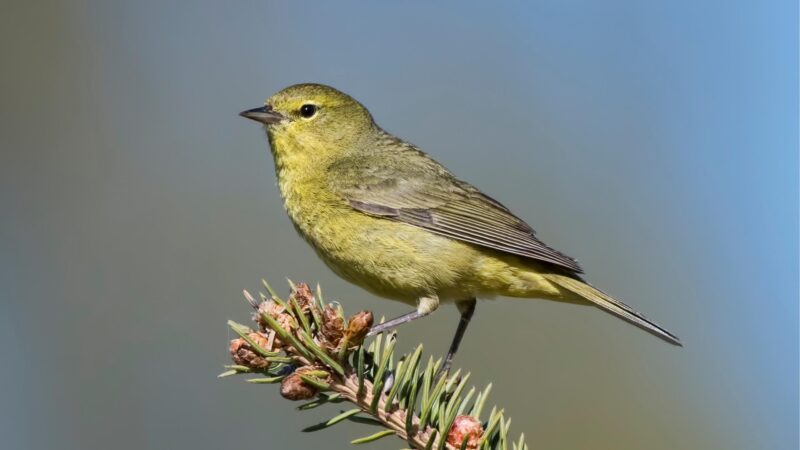
Orange-crowned Warblers are tiny drab-colored songbirds that are usually found in woodland habitats. Their orange crowns are visible when they feel threatened by the presence of other songbirds. Otherwise, they stay mostly hidden from spectators.
- Scientific Name: Leiothlypis celata
- Appearance: Small-sized songbirds that have thinner and pointy beaks compared to other warbler species. Their wings are short and they have square-tipped tails.
- Color: Dull yellow plumage on the belly and breast area while the rump, back, and tail feathers are olive or olive-green in color. They have a distinctive patch of orange found on their crowns and are bolder in color in males.
- Lifespan: Up to 8.6 years (wild)
- Body Length: 11 to 14 centimeters
- Weight: 7 to 11 grams
- Wingspan: 60 to 63 millimeters
- Diet: Mainly invertebrates such as beetles, ants, caterpillars, spiders, and flies. They also feed on berries, fruit, plant galls, seeds, and occasionally, nectar.
- Place of Origin: Alaska and Canada
- Characteristics: Diurnal, territorial, migratory, and solitary unless interacting with mates or their offspring.
Townsend’s Warbler

Townsend’s Warblers are usually abundant in mixed and mature coniferous forests and even in ornamental plant areas with decent amounts of vegetation. During the winter, they like to investigate backyard feeders to forage for food.
- Scientific Name: Setophaga townsendi
- Appearance: Small to medium-sized wood warbler with a slender body, thin but pointed bill, and a tail that has a moderate length
- Color: Males have a black throat and head with a lemon yellow or golden face and a distinctive black cheek patch. Their wings are gray in color with white wing bars. Their backs are olive-green and their breast area is yellow and streaked with black. Females are also similar in appearance but with fewer or dull-colored streaks.
- Lifespan: Up to 10 years
- Body Length: 10.8 to 12.7 centimeters
- Weight: 7.3 to 10.4 grams
- Wingspan: 19 to 21 centimeters
- Diet: Mostly feeds on insects such as ants, stink bugs, beetles, moths, weevils, and bees. They occasionally feed on seeds, leaf galls, and spiders. During winter, they may eat sugary sap.
- Place of Origin: Central America
- Characteristics: Diurnal, territorial, migratory, solitary except during migration and in the winter season
Connecticut Warbler
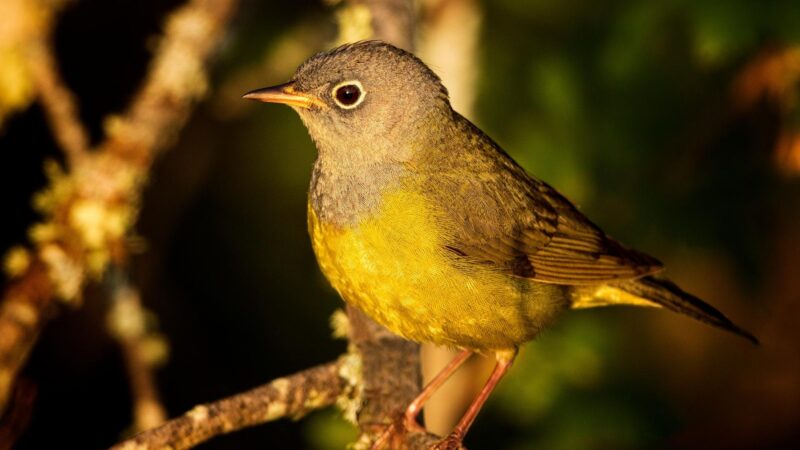
Notoriously shy, elusive, and sluggish birds, Connecticut Warblers thrive in boreal forests, shrubby thickets, and wooded areas. Contrary to their name, they’re not from Connecticut—they’re not even common migrants in the state.
- Scientific Name: Oporornis agilis
- Appearance: Large and plump warbler with large eyes, long legs, short tails, and spike-like bills
- Color: Distinctive gray or brownish hood, bold white eyering, olive upperparts, and yellow underparts. Females are generally more muted than males, with faint-colored hoods.
- Lifespan: Generally unknown but the longest recorded lifespan was 4 years
- Body Length: 13 to 15 centimeters
- Weight: 15 grams
- Wingspan: 22 to 24 centimeters
- Diet: Primarily insects such as beetles, but they also feed on spiders and other arthropods, as well as berries, small seeds, and snails
- Place of Origin: Central Canada and United States
- Characteristics: Territorial, migratory, and mostly solitary, especially during the winter season, but they can also be seen in flocks consisting of up to 20 individuals during migration. They also feed together with other bird species in their breeding areas.
Worm-Eating Warbler
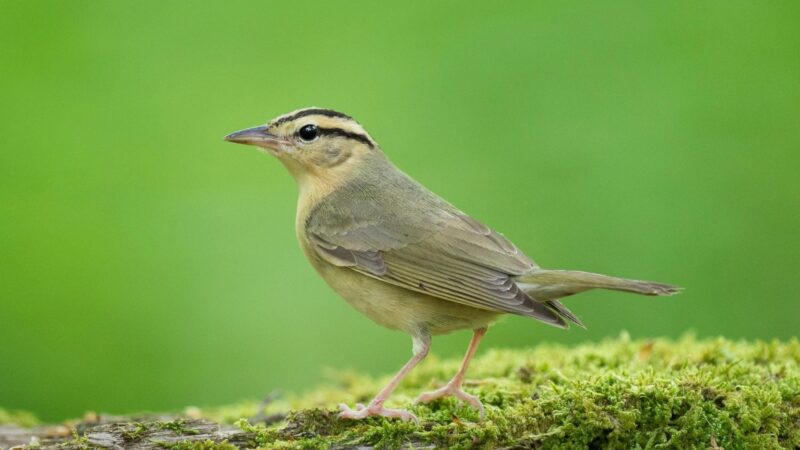
Worm-eating Warblers get their names from their diet, which largely consists of caterpillars that used to be referred to as worms, and not from earthworms. They inhabit forests and forest interiors that have abundant shrubby understories.
- Scientific Name: Helmitheros vermivorum
- Appearance: Small-sized songbird with a long bill shaped like a spike and moderately long tail and wings
- Color: Brownish olive upperparts, a buffy coloration on the head and underparts, bold and black eyeline and stripes on their crown, and pinkish legs
- Lifespan: Up to 8 years
- Body Length: 11.2 to 13.1 centimeters
- Weight: 12 to 14 grams
- Wingspan: 20 to 22 centimeters
- Diet: Primarily caterpillars and grubs but they also feed on spiders, insects, slugs, leafhoppers, beetles, and sawfly larvae.
- Place of Origin: Eastern United States
- Characteristics: Diurnal, territorial, migratory, and solitary but they’re also seen foraging with mixed-species flocks.
Kentucky Warbler
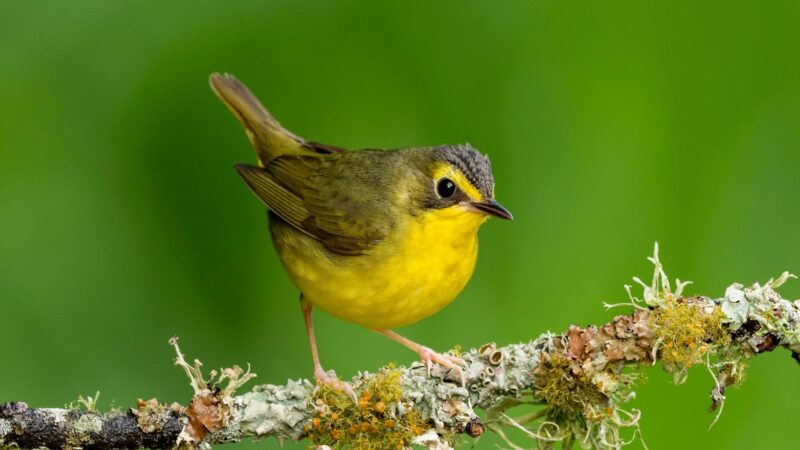
A songbird that is more often heard than seen, Kentucky Warblers inhabit moist forests and woodlands with dense, shrubby understories. Only the males of the species sing with usually only one type of song or call that they voice out at the same pitch their whole lives.
- Scientific Name: Geothlypis formosa
- Appearance: Medium-sized warblers with heavy beaks, long legs, and short tails
- Color: Olive upperparts, yellow underparts, a black-crowned head, and a yellow pattern around the eye that resembles an eyebrow. Females have head patterns that are duller in color compared to males.
- Lifespan: Up to 8 years
- Body Length: 13 centimeters
- Weight: 13 to 14 grams
- Wingspan: 20 to 22 centimeters
- Diet: Primarily insects such as beetles, spiders, ants, locusts, grasshoppers, and caterpillars but they also feed on fruit
- Place of Origin: America
- Characteristics: Diurnal, territorial, migratory, and mostly solitary except during breeding season and nesting.
Hooded Warbler
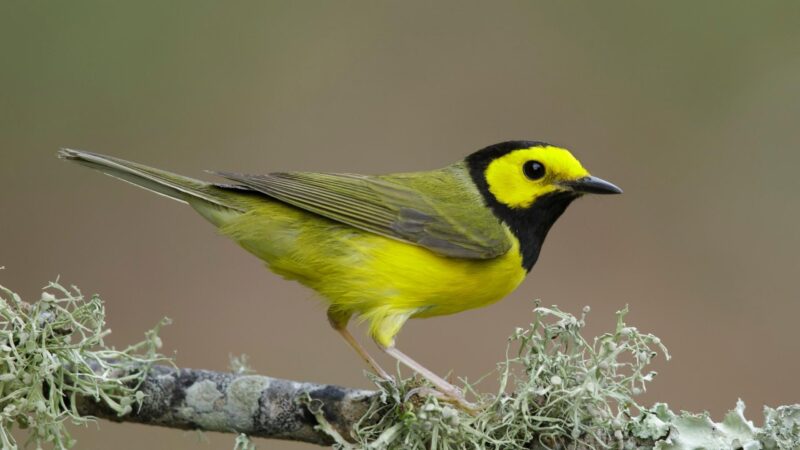
Hooded Warblers are relatively difficult to spot since they live in shrubby forests with thick undergrowths. They have loud, slightly slurred but musical songs and are known to engage in extra-pair matings where females will also breed with males from neighboring territories.
- Scientific Name: Setophaga citrina
- Appearance: Small birds with well-proportioned but heavy bodies, thick necks, and straight, sharp beaks
- Color: Back and upper tail are olive-green or olive-brown in color while underparts are bright yellow. They also have yellow foreheads and cheeks with a black-hooded head and throat. Females don’t have a black hood.
- Lifespan: Up to 9 years
- Body Length: 12.5 to 13 centimeters
- Weight: 9 to 12 grams
- Wingspan: 17.5 centimeters
- Diet: Mainly small insects, spiders, and other species of arthropods
- Place of Origin: Eastern United States and Southeastern Ontario
- Characteristics: Diurnal, territorial, migratory, and generally solitary during the winter and breeding season but they’re also seen joining flocks of mixed-species birds.
Birds that have yellow bellies usually come from the warbler or flycatcher families. They share other common characteristics such as being diurnal, migratory, and eating insectivorous diets. While most are shy, elusive species, some birds on this list can be spotted hovering around bird feeders and flying around your backyards.
List of Sources
Bachynski, K., Kadlec, M. (2003). Dendroica petechia. Animal Diversity Web.
Kirtland’s Warbler. Smithsonian’s National Zoo & Conservation Biology Institute.
Wong, A. (2004). Tyrannus melancholicus. Animal Diversity Web.
Haas, S. (2008). Tyrannus couchii. Animal Diversity Web.
Szalach, E. (2020). Spinus psaltria. Animal Diversity Web.
